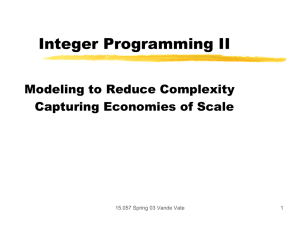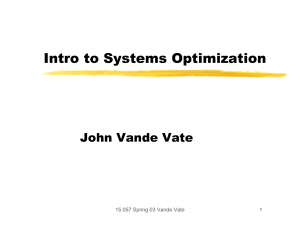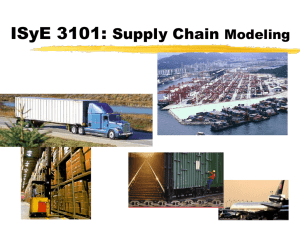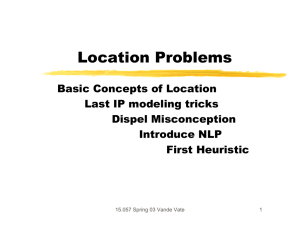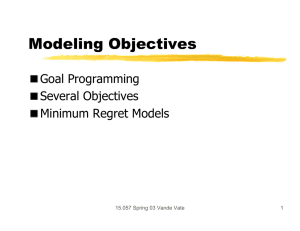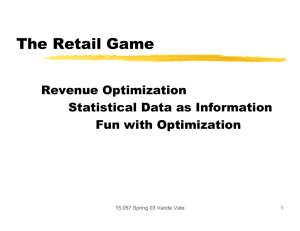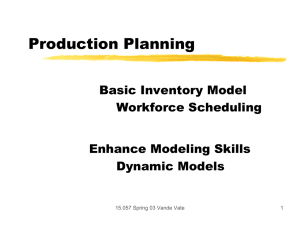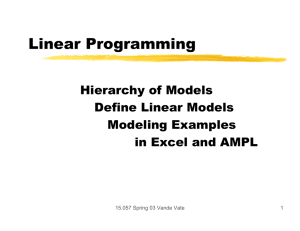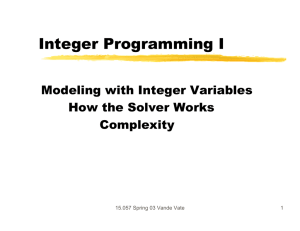Document 13619647
advertisement
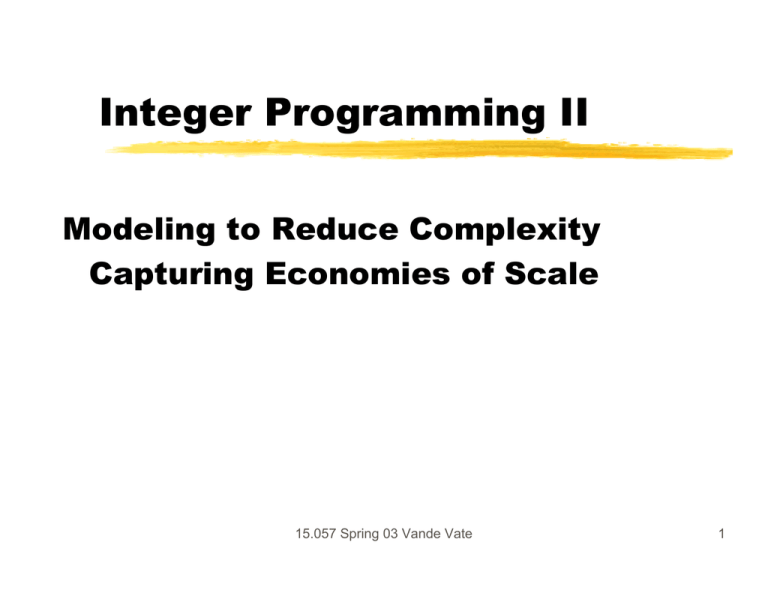
Integer Programming II
Modeling to Reduce Complexity
Capturing Economies of Scale
15.057 Spring 03 Vande Vate
1
Better Models
Better Formulation can distinguish
solvable from not.
Often counterintuitive what’s better
Has led to vastly improved solvers that
actually improve your formulation as they
solve the problem.
15.057 Spring 03 Vande Vate
2
In Theory...
Each new binary variable doubles the difficulty of the problem
Potential Complexity
1E+12
9E+11
8E+11
7E+11
6E+11
5E+11
4E+11
3E+11
2E+11
1E+11
0
0
5
10
15
20
25
No. of Binary Variables
15.057 Spring 03 Vande Vate
30
35
40
45
3
Eliminate Excess Variables
Assign each customer to a DC
s.t. AssignCustomers{cust in CUSTOMERS}:
sum{dc in DCS} Assign[cust, dc] <= 1;
What improvement?
15.057 Spring 03 Vande Vate
4
Add Stronger Constraints
3
Valid Constraint:
Cuts off Fractional Answers
But not Integral Answers
Coils Limit
2
Production Capacity
1
Bands Limit
Coils
1
2
3
15.057 Spring 03 Vande Vate
4
Bands
5
Adding Stronger Constraints
Formulating Current Constraints Better
More constraints are generally better
Use parameters carefully
Creating new constraints that help
Some examples
15.057 Spring 03 Vande Vate
6
More is Better
X, Y, Z binary
Which is better?
Formulation #1
X + Y ≤ 2Z
Formulation #2
X ≤ Z
Y ≤ Z
15.057 Spring 03 Vande Vate
7
Add Stronger Constraints
3
Valid Constraint:
Cuts off Fractional Answers
But not Integral Answers
Coils Limit
2
Production Capacity
1
Bands Limit
Coils
1
2
3
15.057 Spring 03 Vande Vate
4
Bands
8
Adapted from Winston pages 473 and following
Lockbox Example
City
NW
N
NE
SW
S
SE
Oper.Cost
Int. Rate
City
NW
N
NE
SW
S
SE
Total
Open?
Cost
Eff. Cap.
Lockbox Model
Days to Mail from Each Area to Each City
Sea.
Chi.
NY
LA
2
5
5
4
4
2
4
6
5
5
2
8
4
6
8
2
6
6
6
4
8
8
5
5
$ 55,000 $ 50,000 $ 60,000 $ 53,000
6.0%
Sea.
Chi.
NY
LA
0
0
0
0
0
0
0
0
0
0
0
0
0
0
0
0
0
0
0
0
0
0
0
0
0
0
0
0
0
0
0
0
$
$
$
$
0
0
0
0
Total Cost
-
15.057 Spring 03 Vande Vate
Daily Payments
$ 325,000
$ 475,000
$ 300,000
$ 275,000
$ 385,000
$ 350,000
Total
Total Float
0 $
0 $
0 $
0 $
0 $
0 $
Total Float $
Total Cost to Operate
$
-
9
Challenge
Improve the formulation
City
NW
N
NE
SW
S
SE
Oper.Cost
Int. Rate
City
NW
N
NE
SW
S
SE
Total
Open?
Cost
Eff. Cap.
Lockbox Model
Days to Mail from Each Area to Each City
Sea.
Chi.
NY
LA
2
5
5
4
4
2
4
6
5
5
2
8
4
6
8
2
6
6
6
4
8
8
5
5
$ 55,000 $ 50,000 $ 60,000 $ 53,000
6.0%
Sea.
Chi.
NY
LA
0
0
0
0
0
0
0
0
0
0
0
0
0
0
0
0
0
0
0
0
0
0
0
0
0
0
0
0
0
0
0
0
$
$
$
$
0
0
0
0
Total Cost
-
Daily Payments
$ 325,000
$ 475,000
$ 300,000
$ 275,000
$ 385,000
$ 350,000
Total
Total Float
0 $
0 $
0 $
0 $
0 $
0 $
Total Float $
Total Cost to Operate
$
-
Conclusion
Formulation #1
Assign[NW, b] +Assign[N, b] + Assign[NE, b] +
Assign[SW, b] +Assign[S, b] + Assign[SE, b]
≤ 6*Open[b]
Formulation #2
Assign[NW,b] ≤ Open[b]
Assign[N, b] ≤ Open[b]
…
Don’t aggregate or sum constraints
15.057 Spring 03 Vande Vate
11
One Step Further
Impose Constraints at Lowest Level
Some Compromise between
Number of Constraints: How hard to solve LPs
Number of LPs: How many LPs we must solve.
Generally, better to solve fewer LPs.
15.057 Spring 03 Vande Vate
12
Adapted from Moore et al pages 300 and following
Steco Revisited
Steco's Warehouse Location Model
Unit Costs
Warehouse
A
B
C
Lease Unit Cost/Truck to Sales District
2
3
4
($)
1
$ 7,750 $ 170 $ 40 $ 70 $ 160
$ 4,000 $ 150 $ 195 $ 100 $ 10
$ 5,500 $ 100 $ 240 $ 140 $ 60
Monthly Trucks From/To
Decisions Yes/No
Lease A
0
Lease B
0
Lease C
0
Total TrucksTo
Demand (Trucks/Mo)
A
B
C
Totals
Lease
Cost
$ $ $ $ -
1
0
0
0
0
100
To 1
$$$$-
2
0
0
0
0
90
To 2
$$$$-
3
0
0
0
0
110
To 3
$$$ 0
$ 0
4
0
0
0
0
60
Total
0
0
0
Truck
To 4
$
$$ $ (0) $ (0)
$$
0
$ (0) $
0
Eff.
Cap.
0
0
0
Total
Cost
$ $
(0)
$
0
$
0
Cap.
200
250
300
13
Challenge
Improve the formulation
Steco's Warehouse Location Model
Unit Costs
Warehouse
A
B
C
Lease Unit Cost/Truck to Sales District
2
3
4
($)
1
$ 7,750 $ 170 $ 40 $ 70 $ 160
$ 4,000 $ 150 $ 195 $ 100 $ 10
$ 5,500 $ 100 $ 240 $ 140 $ 60
Monthly Trucks From/To
Decisions Yes/No
Lease A
0
Lease B
0
Lease C
0
Total TrucksTo
Demand (Trucks/Mo)
A
B
C
Totals
Lease
Cost
$ $ $ $ -
1
0
0
0
0
100
To 1
$$$$-
2
0
0
0
0
90
To 2
$$$$-
3
0
0
0
0
110
To 3
$$$ 0
$ 0
4
0
0
0
0
60
Total
0
0
0
Truck
To 4
$
$$ $ (0) $ (0)
$$
0
$ (0) $
0
Eff.
Cap.
0
0
0
Total
Cost
$ $
(0)
$
0
$
0
Cap.
200
250
300
More Detailed Constraints
s.t. ShutWarehouse{w in WAREHOUSES}:
sum{d in DISTRICTS} Ship[w,d] <= Capacity[w]*Open[w];
s.t. ShutLanes{w in WAREHOUSES, d in DISTRICTS}:
Ship[w,d] <= Demand[d]*Open[w];
Trade off between work to solve each LP and
number of LPs we have to solve
This makes each one harder, but we solve
fewer.
15.057 Spring 03 Vande Vate
15
Tighten Bounds
Function of Continuous Variables <= Limit*Binary
Variable
Make the Limit as small as possible
But not too small
Don’t eliminate feasible solutions
We will see an Example with Ford Finished Vehicle
Dist.
15.057 Spring 03 Vande Vate
16
New Constraints
Recall the Single Sourcing Problem
15.057 Spring 03 Vande Vate
17
Constraints
s.t. ObserveCapacity{dc in DCS}:
sum{cust in CUSTOMERS}
Demand[cust]*Assign[dc,cust] <= Capacity[dc];
Example: x1, x2, x3, x4, x5, x6 binary
5x1 + 7x2 + 4x3 + 3x4 +4x5 + 6x6 ≤ 14
What constraints can we add?
x1 + x2 + x3 ≤ 2
x1 + x2 + x6 ≤ 2
…
15.057 Spring 03 Vande Vate
18
Total Cost
Non-Linear Costs
Fixed Cost
w
Lo
ge
n
Ra
t/
s
Co
it
n
U
e
Rang
d
i
M
High-Range Cost/Un
t
i
n
U
Cost/
it
Shutdown Cost
Minimum
Sustainable
Level
0
First
Break
Point
Second
Break
Point
Maximum
Operating
Level
Volume of Activity
15.057 Spring 03 Vande Vate
19
Modeling Economies of Scale
Linear Programming
Greedy
Takes the High-Range Unit Cost first!
Integer Programming
Add constraints to ensure first things first
Several Strategies
15.057 Spring 03 Vande Vate
20
Good News!
AMPL offers syntax to “automate” this
Read Chapter 14 of Fourer for details
<<BreakPoint[1], BreakPoint[2]; Slope[1],
Slope[2], Slope[3]>> Variable;
Slope[1] before BreakPoint[1]
Slope[2] from BreakPoint[1] to BreakPoint[2]
Slope[3] after BreakPoint[2]
Has 0 cost at activity 0
15.057 Spring 03 Vande Vate
21
Summary
To control complexity and get solutions
Eliminate unnecessary binary variables
Don’t aggregate constraints
Add strong valid constraints
Tighten bounds
Integer Programming Models can approximate non-linear objectives
15.057 Spring 03 Vande Vate
22
Convex Combination
$27
Weighted Average
What will
the cost
be?
Total Cost
$22
1/5th of the way
First
Break
Point
0
Second
Break
Point
10
15.057 Spring 03 Vande Vate
20
23
Conclusion
If the Volume of Activity is a fraction λ of
the way from one breakpoint to the next,
the cost will be that same fraction of the
way from the cost at the first breakpoint
to the cost at the next
If Volume = 10λ + 20(1-λ)
Then Cost = 22λ + 27(1-λ)
15.057 Spring 03 Vande Vate
24
Idea
Express Volume of Activity as a Weighted
Average of Breakpoints
Express Cost as the same Weighted
Average of Costs at the Breaks
Activity = Min Level λ0 + Break 1 λ1 +
Break 2 λ2 + Max Level λ3
Cost = Cost at Min Level λ0 + Cost at Break 1 λ1 +
Cost at Break 2 λ2 + Cost at Max Level λ3
1 = λ0 + λ1 + λ2 + λ3
15.057 Spring 03 Vande Vate
25
In AMPL Speak
param NBreaks;
param BreakPoint{0..NBreaks};
param CostAtBreak{0..NBreaks};
var Lambda{0..NBreaks} >= 0;
var Activity;
var Cost;
s.t. DefineCost:
Cost = sum{b in 0..NBreaks} CostAtBreak[b]*Lambda[b];
s.t. DefineActivity:
Activity = sum{b in 0..NBreaks} BreakPoint[b]*Lambda[b];
s.t. ConvexCombination:
1 = sum{b in 0..NBreaks}Lambda[b];
15.057 Spring 03 Vande Vate
26
Does that Do It?
Total Cost
What can go wrong?
w
Lo
Minimum
Sustainable
Level
0
ge
n
Ra
t/
s
Co
it
n
U
e
Rang
d
i
M
High-Range Cost/Un
t
i
n
U
Cost/
it
X
First
Break
Point
Second
Break
Point
Maximum
Operating
Level
Volume of Activity
15.057 Spring 03 Vande Vate
27
Role of Integer Variables
Total Cost
Ensure we express Activity as a
combination of two consecutive
breakpoints
var InRegion{1..NBreaks} binary;
InRegion[1]
Minimum
Sustainable
Level
First
Break
Point
InRegion[2]
Second
Break
Point
InRegion[3]
Maximum
Operating
Level
0
15.057 Spring 03 Vande Vate
28
Constraints
Lambda[2] = 0 unless activity is between
Total Cost
BreakPoint[1] and BreakPoint[2] (Region[2]) or
BreakPoint[2] and BreakPoint[3] (Region[3])
Lambda[2] ≤ InRegion[2] + InRegion[3];
InRegion[1]
Minimum
Sustainable
Level
BreakPoint[0]
First
Break
Point
BreakPoint[1]
InRegion[2]
InRegion[3]
Second
Break
Point
BreakPoint[2]
15.057 Spring 03 Vande Vate
Maximum
Operating
Level
BreakPoint[3]
29
And Activity in One Region
InRegion[1] + InRegion[2] + InRegion[3] ≤ 1
Why ≤ 1?
If it is in Region[2]:
Lambda[1] ≤ InRegion[1] + InRegion[2] = 1
Lambda[2] ≤ InRegion[2] + InRegion[3] = 1
Other Lambda’s are 0 15.057 Spring 03 Vande Vate
30
We can’t go wrong
w
Lo
Minimum
Sustainable
Level
0
ge
n
Ra
t/
s
Co
it
n
U
e
Rang
d
i
M
High-Range Cost/Un
t
i
n
U
Cost/
it
X
First
Break
Point
Second
Break
Point
Maximum
Operating
Level
Volume of Activity
15.057 Spring 03 Vande Vate
31
AMPL Speak
param NBreaks;
param BreakPoint{0..NBreaks};
param CostAtBreak{0..NBreaks};
var Lambda{0..NBreaks} >= 0;
var Activity;
var Cost;
s.t. DefineCost:
Cost = sum{b in 0..NBreaks} CostAtBreak[b]*Lambda[b];
s.t. DefineActivity:
Activity = sum{b in 0..NBreaks} BreakPoint[b]*Lambda[b];
s.t. ConvexCombination:
1 = sum{b in 0..NBreaks}Lambda[b];
15.057 Spring 03 Vande Vate
32
What we Added
var InRegion{1..NBreaks} binary;
s.t. InOneRegion:
sum{b in 1..NBreaks} InRegion[b] <= 1;
s.t. EnforceConsecutive{b in 0..NBreaks-1}:
Lambda[b] <= InRegion[b] + InRegion[b+1];
s.t. LastLambda:
Lambda[NBreaks] <= InRegion[NBreaks];
15.057 Spring 03 Vande Vate
33
